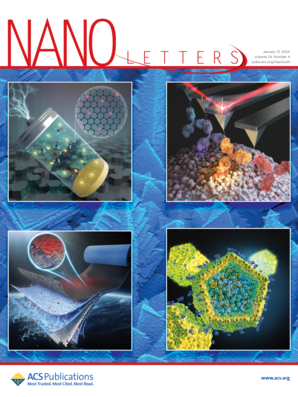All-Optical and Ultrafast Control of High-Order Exciton-Polariton Orbital Modes
IF 9.6
1区 材料科学
Q1 CHEMISTRY, MULTIDISCIPLINARY
引用次数: 0
Abstract
Exciton-polaritons flows within closed quantum circuits can spontaneously form phase-locked modes that carry orbital angular momentum (OAM). With its infinite set of angular momentum quantum numbers (ℏ), high-order OAM represents a transformative solution to the bandwidth bottleneck in multiplexed optical communication. However, its practical application is hindered by the limited choice of materials which in general requires cryogenic temperatures and the reliance on mechanical switching. In this work, we achieve stable and high-order (up to order of 33) OAM modes by constructing a closed quantum circuit using the halide perovskite microcavities at room temperature. By controlling the spatial and temporal symmetry of the closed quantum circuits using another laser pulse, we achieve significant tuning OAM of EP flows from 8ℏ to 12ℏ. Our work demonstrates all-optical and ultrafast control of high-order OAM using exciton-polariton condensates in perovskite microcavities that would have important applications in high-throughput optical communications.

高阶激子-极化子轨道模式的全光和超快控制
封闭量子电路中的激子-极化子流动可以自发形成携带轨道角动量(OAM)的锁相模式。高阶OAM以其无限的角动量量子数(h),为解决复用光通信中的带宽瓶颈提供了一种变革性的解决方案。然而,它的实际应用受到材料选择有限的阻碍,这些材料通常需要低温和依赖机械开关。在这项工作中,我们通过在室温下使用卤化物钙钛矿微腔构建封闭量子电路来实现稳定的高阶(高达33阶)OAM模式。通过使用另一个激光脉冲控制闭合量子电路的时空对称性,我们实现了EP流的OAM在8 ~ 12 μ m范围内的显著调谐。我们的工作展示了在钙钛矿微腔中使用激子-极化子凝聚物的高阶OAM的全光和超快控制,这将在高通量光通信中具有重要应用。
本文章由计算机程序翻译,如有差异,请以英文原文为准。
求助全文
约1分钟内获得全文
求助全文
来源期刊

Nano Letters
工程技术-材料科学:综合
CiteScore
16.80
自引率
2.80%
发文量
1182
审稿时长
1.4 months
期刊介绍:
Nano Letters serves as a dynamic platform for promptly disseminating original results in fundamental, applied, and emerging research across all facets of nanoscience and nanotechnology. A pivotal criterion for inclusion within Nano Letters is the convergence of at least two different areas or disciplines, ensuring a rich interdisciplinary scope. The journal is dedicated to fostering exploration in diverse areas, including:
- Experimental and theoretical findings on physical, chemical, and biological phenomena at the nanoscale
- Synthesis, characterization, and processing of organic, inorganic, polymer, and hybrid nanomaterials through physical, chemical, and biological methodologies
- Modeling and simulation of synthetic, assembly, and interaction processes
- Realization of integrated nanostructures and nano-engineered devices exhibiting advanced performance
- Applications of nanoscale materials in living and environmental systems
Nano Letters is committed to advancing and showcasing groundbreaking research that intersects various domains, fostering innovation and collaboration in the ever-evolving field of nanoscience and nanotechnology.
 求助内容:
求助内容: 应助结果提醒方式:
应助结果提醒方式:


